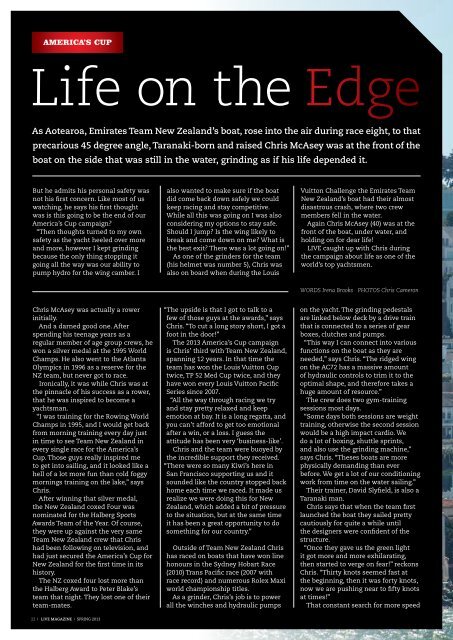Download this Issue - Live Magazine
Download this Issue - Live Magazine
Download this Issue - Live Magazine
- No tags were found...
You also want an ePaper? Increase the reach of your titles
YUMPU automatically turns print PDFs into web optimized ePapers that Google loves.
AMERICA’S CUPLife on the EdgeAs Aotearoa, Emirates Team New Zealand’s boat, rose into the air during race eight, to thatprecarious 45 degree angle, Taranaki-born and raised Chris McAsey was at the front of theboat on the side that was still in the water, grinding as if his life depended it.But he admits his personal safety wasnot his first concern. Like most of uswatching, he says his first thoughtwas is <strong>this</strong> going to be the end of ourAmerica’s Cup campaign?“Then thoughts turned to my ownsafety as the yacht heeled over moreand more, however I kept grindingbecause the only thing stopping itgoing all the way was our ability topump hydro for the wing camber. Ialso wanted to make sure if the boatdid come back down safely we couldkeep racing and stay competitive.While all <strong>this</strong> was going on I was alsoconsidering my options to stay safe.Should I jump? Is the wing likely tobreak and come down on me? What isthe best exit? There was a lot going on!”As one of the grinders for the team(his helmet was number 5), Chris wasalso on board when during the LouisVuitton Challenge the Emirates TeamNew Zealand’s boat had their almostdisastrous crash, where two crewmembers fell in the water.Again Chris McAsey (40) was at thefront of the boat, under water, andholding on for dear life!LIVE caught up with Chris duringthe campaign about life as one of theworld’s top yachtsmen.WORDS Irena Brooks PHOTOS Chris CameronChris McAsey was actually a rowerinitially.And a darned good one. Afterspending his teenage years as aregular member of age group crews, hewon a silver medal at the 1995 WorldChamps. He also went to the AtlantaOlympics in 1996 as a reserve for theNZ team, but never got to race.Ironically, it was while Chris was atthe pinnacle of his success as a rower,that he was inspired to become ayachtsman.“I was training for the Rowing WorldChamps in 1995, and I would get backfrom morning training every day justin time to see Team New Zealand inevery single race for the America’sCup. Those guys really inspired meto get into sailing, and it looked like ahell of a lot more fun than cold foggymornings training on the lake,” saysChris.After winning that silver medal,the New Zealand coxed Four wasnominated for the Halberg SportsAwards Team of the Year. Of course,they were up against the very sameTeam New Zealand crew that Chrishad been following on television, andhad just secured the America’s Cup forNew Zealand for the first time in itshistory.The NZ coxed four lost more thanthe Halberg Award to Peter Blake’steam that night. They lost one of theirteam-mates.“The upside is that I got to talk to afew of those guys at the awards,” saysChris. “To cut a long story short, I got afoot in the door!”The 2013 America’s Cup campaignis Chris’ third with Team New Zealand,spanning 12 years. In that time theteam has won the Louis Vuitton Cuptwice, TP 52 Med Cup twice, and theyhave won every Louis Vuitton PacificSeries since 2007.“All the way through racing we tryand stay pretty relaxed and keepemotion at bay. It is a long regatta, andyou can’t afford to get too emotionalafter a win, or a loss. I guess theattitude has been very ‘business-like’.Chris and the team were buoyed bythe incredible support they received.“There were so many Kiwi’s here inSan Francisco supporting us and itsounded like the country stopped backhome each time we raced. It made usrealize we were doing <strong>this</strong> for NewZealand, which added a bit of pressureto the situation, but at the same timeit has been a great opportunity to dosomething for our country.”Outside of Team New Zealand Chrishas raced on boats that have won linehonours in the Sydney Hobart Race(2010) Trans Pacific race (2007 withrace record) and numerous Rolex Maxiworld championship titles.As a grinder, Chris’s job is to powerall the winches and hydraulic pumpson the yacht. The grinding pedestalsare linked below deck by a drive trainthat is connected to a series of gearboxes, clutches and pumps.“This way I can connect into variousfunctions on the boat as they areneeded,” says Chris. “The ridged wingon the AC72 has a massive amountof hydraulic controls to trim it to theoptimal shape, and therefore takes ahuge amount of resource.”The crew does two gym-trainingsessions most days.“Some days both sessions are weighttraining, otherwise the second sessionwould be a high impact cardio. Wedo a lot of boxing, shuttle sprints,and also use the grinding machine,”says Chris. “Theses boats are morephysically demanding than everbefore. We get a lot of our conditioningwork from time on the water sailing.”Their trainer, David Slyfield, is also aTaranaki man.Chris says that when the team firstlaunched the boat they sailed prettycautiously for quite a while untilthe designers were confident of thestructure.“Once they gave us the green lightit got more and more exhilarating,then started to verge on fear!” reckonsChris. “Thirty knots seemed fast atthe beginning, then it was forty knots,now we are pushing near to fifty knotsat times!”That constant search for more speed22 I LIVE MAGAZINE I SPRING 2013


